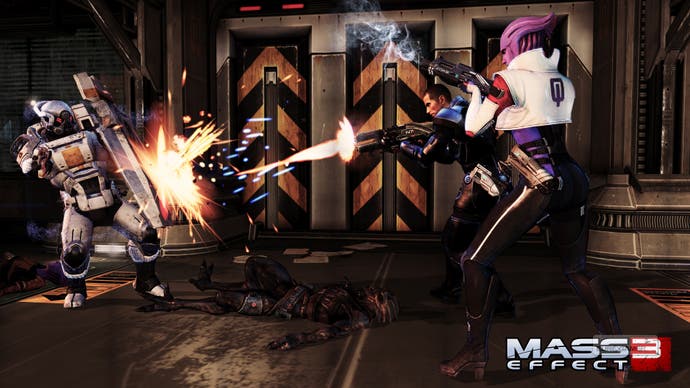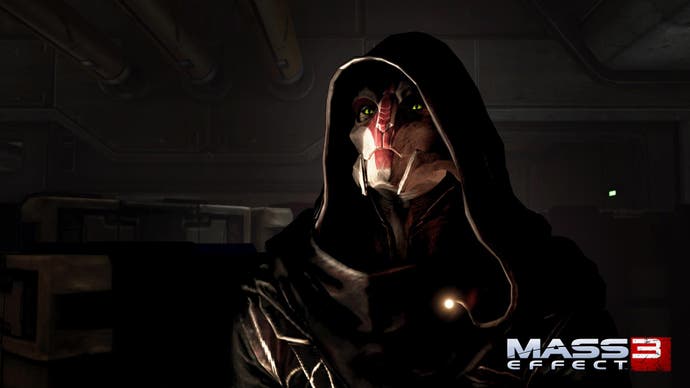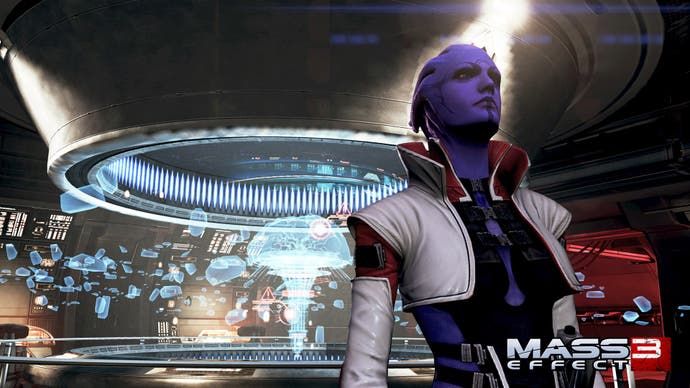Mass Effect 3: Omega review
Aria sure you want to buy it?
BioWare is trying something different with Mass Effect 3: Omega. After Leviathan, a story-fuelled race around the galaxy that wrapped revelatory new lore around dazzling locations and likeable characters, Mass Effect fans get the opposite. Omega is a dark, hard-fought slog through the belly of the dingy Mass Effect 2 space station. It rambles, it gets lost, and it ultimately feels weightless.
Omega's story centres on angry asari Aria T'loak. She's on a mission to reclaim rule following a Cerberus coup (for full details, read the comics). Whether you'll be interested really depends on whether you like the character - this add-on is an entirely separate four-hour diversion from Mass Effect 3's main arc. At no point does anyone else you've met throughout the game's 40-plus hours matter a jot. This is a side-story, a complete digression. There's nothing wrong with that, of course - except that when it's over, everything feels exactly the same.
This may be why BioWare ultimately decided not to include a planned Omega mission in the main game. A different version of T'loak's quest to regain control exists in an early version of the game's script, despite BioWare's protestations that work on this downloadable content was not started until Mass Effect 3 shipped. Omega is perfect DLC fodder, on the surface similar to Mass Effect 2's Lair of the Shadow Broker. Both campaigns are hinted at within the main game and both feature a well-known character on a personal mission. Yet where Shadow Broker offered up new locations, plot progression and a nifty new base to hang around in, Omega offers none of the above.
Instead, Omega is most comparable to Mass Effect 2's Arrival, a disappointing expansion that saw Shepard leave his team behind and embark on a meandering quest to bridge the story between Mass Effect 2 and 3. Here Shepard isn't even able to do that, and once the excuses are made that he must go alone (Aria doesn't like who he travels with, apparently), your squadmates and the Normandy are gone. It's an excuse that barely works in Arrival and serves no story purpose here. Shepard leaves his crack team, only to find himself needing another crack team to retake Omega.

There are obviously budgetary reasons why this is the case - voicing up to eight squadmates when one is a piece of DLC himself and others can be dead is costly, and there's a good argument for a side-story with light shone on new characters. Not to mention the fact that Carrie-Anne Moss' vocal talents as T'loak can't come cheap. To be fair, Moss puts in an admirable performance with a mostly-average BioWare script.
But the character of Nyreen, Shepard's other temporary companion, is entirely wasted. BioWare made a fanfare of her reveal - the series' first female turian - but her screen-time throughout totals about an hour. She's playable for around a quarter of the game's campaign as she flits in and out, and the way her character is handled is appalling. Shepard is sometimes left entirely on his own, an irritating decision for a game that trains players to use a team of complementing characters, and a cheap way of upping the difficulty instead of ever providing a real boss.
Omega does add two new enemy types, however, which is something Leviathan's waves of familiar Reaper foes lacked. First is the Rampart Mech, a nod back to Mass Effect 2's LOKIs. Ramparts are souped-up versions, able to entirely shield themselves for a limited time and enter an overclocked mode where they aim straight for you, whether you think you're tucked away safe or not. Also new are the Adjutants: hulking, bulbous-headed Reaper enemies who originated in the Mass Effect comics. They can leap around the map and slam you with biotic powers.
Both challenge the way experienced players eye the battlefield - and those who simply hog the nearest bit of cover will be sent running. Combat is by far the best aspect of Omega; BioWare has admitted studying the way players fight in the game's multiplayer mode to improve its level design. In this it has thoroughly succeeded.

But while the layout of levels may have improved, the overall setting soon becomes wearisome. Your return to one of Mass Effect 2's iconic locations is initially exciting, but after an hour you become tired of its burnt oranges and browns, its dirt and grime. The DLC feels like one regular mission stretched out over four hours and BioWare saves the locations you'll actually recognise until the game's dying moments. As for the rest - well, if there was a travel brochure of places on Omega to visit, none of them would appear here.
There are two standout areas: the inside of a mine where you cross a giant drill shaft and a spooky lights-off introduction to the Adjutants, whose snuffling breathing emulates Resident Evil 4's Regenerators. But too much time is spent in corridors and the much-anticipated hub area for the game turns out to be little more than a dingy office. Omega was an interesting location due to its neon-lit markets bustling with batarians, its sleazy nightclub and squalid wards. These are seen - glimpsed - but mostly from afar.
The hub area - a command post for Aria and Nyreen - offers a few side-missions: collectables to find while progressing through the main story. But it's an entirely linear storyline, and once complete, Omega vanishes. Unlike Shadow Broker, you cannot return - BioWare does not even add the system to your Galaxy Map, despite you having been there. You can't go back, you can't even fly past. Re-enter the Citadel when you're done and Aria is back sitting on the same couch where she's been for the entirety of the game. It's like nothing has changed.

And it hasn't. Shepard is again given the illusion of choice - he can choose to save or kill in a couple of places, but in the end the decisions don't amount to anything. Insultingly, the only real story branch dependent on your dialogue options is how Aria acts at the close of this chapter. If you've acted like a badass she might pucker up and give you a kiss. (If you're wondering: I played as a Paragon and she didn't.)
Some might moan that Omega should have been part of the main game. I'm glad it isn't, although I do believe it would have worked better shrunk down to the length of a single mission. It's refreshing to get to the point where BioWare doesn't feel the need to address the main game's faults yet again in its DLC (the Extended Cut and Leviathan's story points were all conceived post-release) - but it's also worrying because Omega has been planned for far longer. BioWare has had a year to get Omega right. It didn't.

